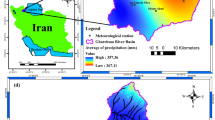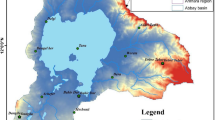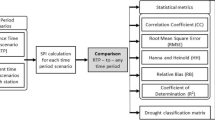Abstract
Loglinear models for three-dimensional contingency tables was used with data from 21 rainfall stations and 7 hydrometric stations in the Luanhe river basin, northeast China, for short term prediction of drought severity class. Loglinear models were fitted to drought class transitions derived from standardized precipitation index (SPI) and standardized runoff index (SRI) time series to find which series was more suitable for hydrological drought class prediction 1 and 2 months ahead, respectively. Expected frequencies for two consecutive transitions between drought classes were first calculated, and based on this the predicted drought classes 1 and 2 months ahead were obtained. The results showed that despite the contingency tables of drought class transitions presented the maintenance of the precedent drought class, results of three-dimensional loglinear modeling presented good results when comparing predicted and observed drought classes. Only for a few cases predictions did not fully match the observed drought class, mainly for 2-month lead and when the SRI values are near the limit of the severity class predicted by SRI time series. Based on the correlation analysis of SPI and SRI, we presented the well-known method of hydrological drought class prediction by SPI time series. It was found that, using loglinear regression method, the accuracy of predictions for 2-month lead predicted by SPI time series was higher than those predicted by SRI time series. When we divided the SPI and SRI time series into 2 sub-periods (pre- and post-1980 where land cover changed), we got the same drought class prediction as that predicted by the entire SPI and SRI time series, which illustrated that changes in land use did not affect predictions of hydrological drought classes in the Luanhe river basin. It could be concluded that loglinear prediction of drought class transitions is a useful tool for short term hydrological drought warning, and the results could provide significant information for water resources managers and policy makers to mitigate drought effects.

Similar content being viewed by others
References
Agresti A (1990) Categorical data analysis. John Wiley & Sons, New York
Byun HR, Wilhite DA (1999) Objective quantification of drought severity and duration. J Climatol 12:2747–2756
Cancelliere A, Mauro GD, Bonaccorso B et al (2007) Drought forecasting using the standardized precipitation index. Water Resour Manag 21:801–819
Changnon SA, Vonnahme DR, Masce PE (2003) Impact of spring 2000 drought forecasts on Midwestern water management. J Water Resour Plan Manag 129:18–25
Feng P, Li JZ, Xu X (2008) Analysis of water resources trend and its causes of Panjiakou reservoir. Geogr Res 27:213–220
Feng P, Hu R, Li JZ (2014) Study on the meteorological drought grade prediction using three-dimensional loglinear models. J Hydraul Eng 45:505–512
Haan CT (2002) Statistical methods in hydrology. The Iowa State University Press, Ames
Haihe River Water Conservancy Commission (2009) Flood and drought disasters in Haihe River Basin. Tianjin Science and Technology Press, Tianjin
Han P, Wang PX, Zhang SY et al (2010) Drought forecasting based on the remote sensing data using ARIMA models. Math Comput Model 51:1398–1403
Hao Z, AghaKouchak A (2013) Multivariate standardized drought index: a parametric multi-index model. Adv Water Resour 57:12–18
Hewitt K (1997) Regions at risk: a geographical introduction to disasters. Addison-Wesley Longman, UK
Huang SZ, Chang JX, Huang Q et al (2014) Spatio-temporal changes and frequency analysis of drought in the Weihe river basin, China. Water Resour Manag 28:3095–3110
Kao S, Govindaraju RS (2010) A copula-based joint deficit index for droughts. J Hydrol 380:121–134
Kim T, Valdes JB (2003) Nonlinear model for drought forecasting based on a conjunction of wavelet transforms and neural networks. J Hydrol Eng 8:319–328
Li JZ, Feng P (2007) Runoff variations in the Luanhe river basin during 1956–2002. J Geogr Sci 17:339–350
Li JZ, Tan SM, Chen FL et al (2014) Quantitatively analyze the impact of land use/land cover change on annual runoff decrease. Nat Hazards 74:1191–1207
Liu WT, Negron-Juarez RI (2001) ENSO drought onset prediction in northeast Brazil using NDVI. Int J Remote Sens 22:3483–3501
Liu L, Hong Y, Bednarczyk CN et al (2012) Hydro-climatological drought analysis and projections using meteorological and hydrological drought indices: a case study in Blue River Basin, Oklahoma. Water Resour Manag 26:2761–2779
Ma HJ, Yan DH, Weng BS et al (2013) Applicability of typical drought indices in the Luanhe River Basin. Arid Zone Res 30:728–734
McKee TB, Doesken NJ, Kleist J (1993) The relationship of drought frequency and duration to time scales, paper presented at 8th conference on applied climatology. American Meteorological Society, Anaheim
Mendicino G, Senatore A, Versace P (2008) A groundwater resource index (GRI) for drought monitoring and forecasting in a Mediterranean climate. J Hydrol 357:282–302
Mishra V, Cherkauer KA (2009) Assessment of drought due to historic climate variability and projected future climate change in the Midwestern United States. J Hydrometeorol 11:46–68
Mishra AK, Desai VR (2005a) Drought forecasting using stochastic models. Stoch Env Res Risk A 19:326–339
Mishra AK, Desai VR (2005b) Spatial and temporal drought analysis in the Kansabati River Basin, India. Int JRiver Basin Manag 3:31–41
Mishra AK, Desai VR (2006) Drought forecasting using feed forward recursive neural network. Int J Ecol 198:127–138
Mishra AK, Singh VP (2010) A review of drought concepts. J Hydrol 391:202–216
Mishra AK, Singh VP (2011) Drought modeling—a review. J Hydrol 403:157–175
Mishra AK, Desai VR, Singh VP (2007) Drought forecasting using a hybrid stochastic and neural network model. J Hydrol Eng ASCE 12:626–638
Mishra AK, Singh VP, Desai VR (2009) Drought characterization: a probabilistic approach. Stoch Env Res Risk A 23:41–55
Moreira EE, Paulo AA, Pereira LS et al (2006) Analysis of SPI drought class transitions using loglinear models. J Hydrol 331:349–359
Moreira EE, Coelho CA, Paulo AA et al (2008) SPI-based drought category prediction using loglinear models. J Hydrol 354:116–130
Morid S, Smakhtin V, Moghaddasi M (2006) Comparison of seven meteorological indices for drought monitoring in Iran. Int J Climatol 26:971–985
Nalbantis I, Tsakiris G (2009) Assessment of hydrological drought revisited. Water Resour Manag 23:881–897
Narasimhan B, Srinivasan R (2005) Development and evaluation of soil moisture deficit index (SMDI) and evapotranspiration deficit index (ETDI) for agricultural drought monitoring. Agric For Meteorol 133:69–88
Nichols N, Coughlan MJ, Monnik K (2005) The challenge of climate prediction in mitigating drought impacts. In: Wilhite DA (ed) Drought and water crisis. Science technology, and management issues. Taylor & Francis, Boca Raton, pp 33–51
Özger M, Mishra AK, Singh VP (2009) Low frequency variability in drought events associated with climate indices. J Hydrol 364:152–162
Palmer WC (1967) The abnormally dry weather of 1961–1966 in the Northeastern United States. In: Jerome S (ed) Proceedings of the conference on the drought in the Northeastern United States, New York University Geophysical Research Laboratory Report TR-68-3, pp 32–56
Paulo AA, Pereira LS (2007) Prediction of SPI drought class transitions using Markov chains. Water Resour Manag 21:1813–1827
Paulo AA, Pereira LS (2008) Stochastic prediction of drought class transitions. Water Resour Manag 22:1277–1296
Paulo AA, Ferreira E, Coelho C et al (2005) Drought class transition analysis through Markov and Loglinear models, an approach to early warning. Agric Water Manag 77:59–81
Rao AR, Padmanabhan G (1984) Analysis and modeling of Palmer’s drought index series. J Hydrol 68:211–229
Rossi G, Vega T, Bonaccorso B (2007) Methods and tools for drought analysis and management. Springer
Schubert S, Gutzler D, Wang H et al (2009) A U.S. CLIVAR project to assess and compare the responses of global climate models to drought-related SST forcing patterns: overview and results. J Clim 22:5251–5272
Shukla S, Wood AW (2008) Use of a standardized runoff index for characterizing hydrologic drought. Geophys Res Lett 35, L02405. doi:10.1029/2007GL032487
Soule PT (1993) Spatial patterns of drought frequency and duration in the contiguous USA based on multiple drought event definitions. Int J Climatol 12:11–24
Steinemann AC (2006) Using climate forecasts for drought management. J Appl Meteorol Climatol 45:1353–1361
Tabari H, Nikbakht J, Talaee PH (2013) Hydrological drought assessment in Northwestern Iran based on streamflow drought index (SDI). Water Resour Manag 27:137–151
Tsakiris G, Pangalou D, Vangelis H (2007) Regional drought assessment based on the reconnaissance drought index (RDI). Water Resour Manag 21:821–833
Tsakiris G, Nalbantis I, Vangelis H et al (2013) A system-based paradigm of drought analysis for operational management. Water Resour Manag 27:5281–5297
Vasiliades L, Loukas A, Liberis N (2011) A water balance derived drought index for Pinios river basin, Greece. Water Resour Manag 25:1087–1101
Wang W, Shao Q, Yang T et al (2013) Quantitative assessment of the impact of climate variability and human activities on runoff changes: a case study in four catchments of the Haihe River basin, China. Hydrol Process 27:1158–1174
Wilhite DA (2000) Drought as a natural hazard: concepts and definitions. In: Wilhite DA (ed) Drought: a global assessment, hazards disasters Ser., vol. I. Routledge, New York, pp 3–18
Acknowledgments
This work was supported by National Natural Science Foundation of China (No. 51479130). We are also grateful to Hydrology and Water Resource Survey Bureau of Hebei Province for providing the hydrological data.
Author information
Authors and Affiliations
Corresponding author
Rights and permissions
About this article
Cite this article
Li, J., Zhou, S. & Hu, R. Hydrological Drought Class Transition Using SPI and SRI Time Series by Loglinear Regression. Water Resour Manage 30, 669–684 (2016). https://doi.org/10.1007/s11269-015-1184-7
Received:
Accepted:
Published:
Issue Date:
DOI: https://doi.org/10.1007/s11269-015-1184-7




